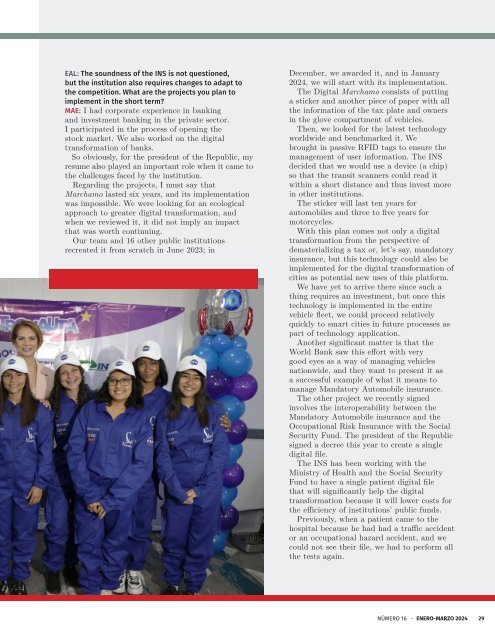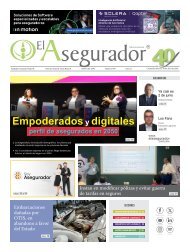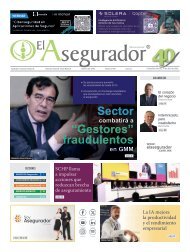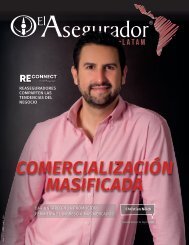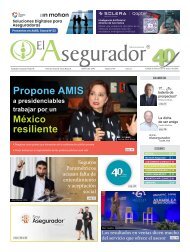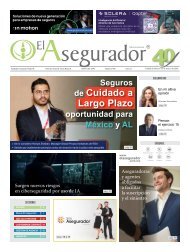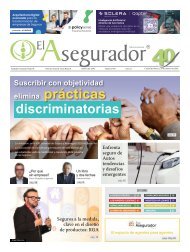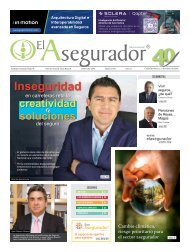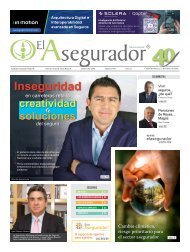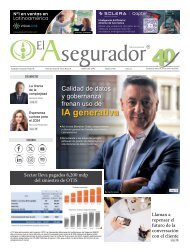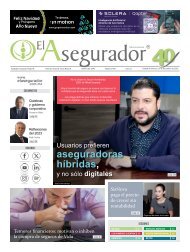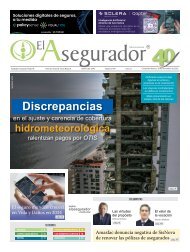El Asegurador LATAM Ene-Mar 24
En la nueva edición de El Asegurador LATAM, revista de negocios diseñada para el sector seguros de Latinoamérica, Mónica Araya Esquivel, presidenta ejecutiva de Grupo INS de Costa Rica, recomienda a la industria fomentar la cultura de previsión en la sociedad aprovechando las ventajas de la tecnología. Asimismo, encontrará todos los detalles del reencuentro del sector en la FIDES Río 2023.
En la nueva edición de El Asegurador LATAM, revista de negocios diseñada para el sector seguros de Latinoamérica, Mónica Araya Esquivel, presidenta ejecutiva de Grupo INS de Costa Rica, recomienda a la industria fomentar la cultura de previsión en la sociedad aprovechando las ventajas de la tecnología.
Asimismo, encontrará todos los detalles del reencuentro del sector en la FIDES Río 2023.
You also want an ePaper? Increase the reach of your titles
YUMPU automatically turns print PDFs into web optimized ePapers that Google loves.
EAL: The soundness of the INS is not questioned,<br />
but the institution also requires changes to adapt to<br />
the competition. What are the projects you plan to<br />
implement in the short term?<br />
MAE: I had corporate experience in banking<br />
and investment banking in the private sector.<br />
I participated in the process of opening the<br />
stock market. We also worked on the digital<br />
transformation of banks.<br />
So obviously, for the president of the Republic, my<br />
resume also played an important role when it came to<br />
the challenges faced by the institution.<br />
Regarding the projects, I must say that<br />
<strong>Mar</strong>chamo lasted six years, and its implementation<br />
was impossible. We were looking for an ecological<br />
approach to greater digital transformation, and<br />
when we reviewed it, it did not imply an impact<br />
that was worth continuing.<br />
Our team and 16 other public institutions<br />
recreated it from scratch in June 2023; in<br />
December, we awarded it, and in January<br />
20<strong>24</strong>, we will start with its implementation.<br />
The Digital <strong>Mar</strong>chamo consists of putting<br />
a sticker and another piece of paper with all<br />
the information of the tax plate and owners<br />
in the glove compartment of vehicles.<br />
Then, we looked for the latest technology<br />
worldwide and benchmarked it. We<br />
brought in passive RFID tags to ensure the<br />
management of user information. The INS<br />
decided that we would use a device (a chip)<br />
so that the transit scanners could read it<br />
within a short distance and thus invest more<br />
in other institutions.<br />
The sticker will last ten years for<br />
automobiles and three to five years for<br />
motorcycles.<br />
With this plan comes not only a digital<br />
transformation from the perspective of<br />
dematerializing a tax or, let’s say, mandatory<br />
insurance, but this technology could also be<br />
implemented for the digital transformation of<br />
cities as potential new uses of this platform.<br />
We have yet to arrive there since such a<br />
thing requires an investment, but once this<br />
technology is implemented in the entire<br />
vehicle fleet, we could proceed relatively<br />
quickly to smart cities in future processes as<br />
part of technology application.<br />
Another significant matter is that the<br />
World Bank saw this effort with very<br />
good eyes as a way of managing vehicles<br />
nationwide, and they want to present it as<br />
a successful example of what it means to<br />
manage Mandatory Automobile insurance.<br />
The other project we recently signed<br />
involves the interoperability between the<br />
Mandatory Automobile insurance and the<br />
Occupational Risk Insurance with the Social<br />
Security Fund. The president of the Republic<br />
signed a decree this year to create a single<br />
digital file.<br />
The INS has been working with the<br />
Ministry of Health and the Social Security<br />
Fund to have a single patient digital file<br />
that will significantly help the digital<br />
transformation because it will lower costs for<br />
the efficiency of institutions’ public funds.<br />
Previously, when a patient came to the<br />
hospital because he had had a traffic accident<br />
or an occupational hazard accident, and we<br />
could not see their file, we had to perform all<br />
the tests again.<br />
NÚMERO 16 - ENERO-MARZO 20<strong>24</strong> 29


